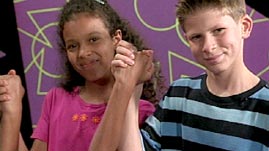Teachers' Domain - Digital Media for the Classroom and Professional Development
User: Preview


Source: ZOOM
Exploring Conductivity: Lemon Battery II (Document)
(humming) (gasps) Ooh!
GARRETT: When Kaleigh and I did our lemon battery experiment, we discovered that electricity could pass through our bodies. What if you go like this?
GARRETT and KALEIGH: Ooh! Oh, yeah, it works! This is so cool!
GARRETT: The electrons are going through both of us and going into the clock! Oh, my gosh!
Well, Natalie e-mailed us this challenge to see how many people we can have the electrons go through and still have the clock on. Mike, do you want to come out and help me with this?
MIKE: Sure.
GARRETT: So, we know that if we disconnect any part of the circuit, it's not going to work. What if we cut it...
MIKE: Cut the lemon?
GARRETT: Yeah, cut the lemon.
MIKE: All right, all right, try that.
GARRETT: So, right when I cut it...
MIKE: It's going to disconnect as soon as the two lemons come apart. Here, try holding the two lemons. Does it...?
GARRETT: Oh, that's so cool! It's because the electrons go up through my arm, and then back down the other one to complete the circuit. Hey, wait a minute. Why don't you hold this one? If I hold this one, does it go off?
MIKE: It goes right off. So, when we hold hands, it turns back on. So, want to try more people?
GARRETT: That's so cool, yeah, sure. Aline, do you want to come out and help us?
ALINE: Sure.MIKE: So the circuit's disconnected.
GARRETT: So the circuit's disconnected.
MIKE: You have to come between us.
GARRETT: And so if we hold hands, it might...
ALINE: Is it working?
GARRETT: It's still working!
ALINE: Oh, my gosh!
GARRETT: It's so cool! Estuardo, do you want to come on out and help us? Estuardo, come on over. So, this is four people. And it still works! Oh, that's so cool.
ESTUARDO: That's awesome!
CAROLINE: Hold on tight, guys.
SHING YING: Come on, Kortney!
ALINE: You guys, why don't we...
ALL: It works! (cheer)
CAROLINE: I didn't think it would work because I thought the resistance— like the flow of electrons— was going to...
SHING YING: Well, I guess because we're, like, all connected here, it goes through Mike and you and Estuardo.
ZOOMer: It's off. It's on. It's off.
GARRETT: You guys want to try it with the voltmeter now?
SHING YING: Sure.
GARRETT: Do you want to test it out first?
MIKE: Yeah, let's try it with the lemons first.
GARRETT: So let's see how much...
MIKE: Way up there.
GARRETT: So that's 16 millivolts. Now try...
MIKE: Let's try connecting hands.
GARRETT: So it's four or five.
MIKE: Four or five.
GARRETT: What do you think's going to happen if we add more people?
MIKE: I think there's going to be a definite decrease in voltage.
GARRETT: Yeah, me, too.
MIKE: The more people there are, the more resistance there's going to be from body to body, and I think this is definitely going to be decreased.
GARRETT: Caroline, do you want to come on up? So, you'll come in the middle. (gasps)
CAROLINE: Wow! It's the same!
GARRETT: In between three and four.
GARRETT: Kortney, you want to come on out?
MIKE: Hey, Kortney.
CAROLINE: We're testing the voltage of...
GARRETT: Almost four again. That's... it's a little bit less and that's got us on the three.
SHING YING: Come on, Aline!
ALINE: I don't know if it's going to work. Do you think it's going to work?
GARRETT: I don't think it's going to work.
ALL: (cheering)
ESTUARDO: Conductors are materials that allow electrons to move through them. The wires of the lemon battery are conductors. And we're conductors!
KORTNEY: The path that electrons flow through is called a circuit. When the circuit is connected, the electricity can flow. When the circuit is broken, the electrons can't flow.
SHING YING: So the next time you turn off a light, you can think about the fact that you're disconnecting a circuit. Uh, can somebody please reconnect the circuit? Thanks!
 Loading Standards
Loading Standards Teachers' Domain is proud to be a Pathways portal to the National Science Digital Library.
Teachers' Domain is proud to be a Pathways portal to the National Science Digital Library.
